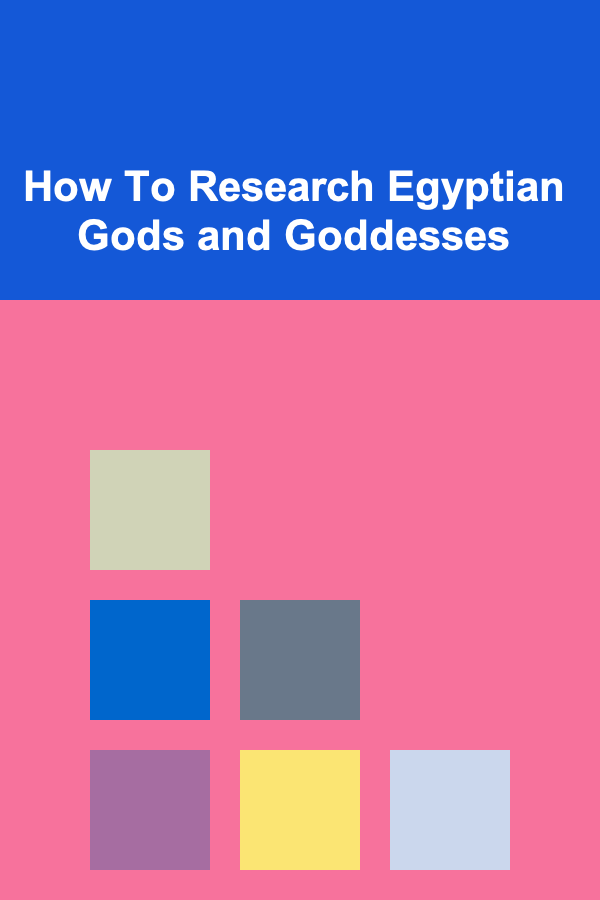
How To Research Egyptian Gods and Goddesses
ebook include PDF & Audio bundle (Micro Guide)
$12.99$10.99
Limited Time Offer! Order within the next:

Researching Egyptian gods and goddesses is a fascinating journey into the ancient world of Egypt, where religion played a central role in the lives of its people. The gods and goddesses of Egypt were not merely subjects of worship but embodied the very forces of nature, social order, and the afterlife. This article will guide you through the process of researching Egyptian gods and goddesses, providing an in-depth exploration of their origins, roles, and the resources that can aid in your research.
Understanding the Role of Egyptian Gods and Goddesses
Egyptian religion was polytheistic, meaning that there were numerous gods and goddesses who governed various aspects of the world. These deities were seen as both powerful and approachable, with their influence permeating the realms of nature, society, and the cosmos. Each deity had a unique role, personality, and area of influence. Some gods represented specific natural elements, such as the sun, the Nile, or the earth, while others embodied concepts like truth, justice, or fertility.
Major Egyptian Deities
- Ra: The sun god, often regarded as the most powerful of the Egyptian gods. He was the creator god and the ruler of the sky. Ra was depicted with the head of a falcon and a sun disk above it.
- Osiris: God of the afterlife, resurrection, and fertility. Osiris was the brother and husband of Isis, and his myth represents themes of death, rebirth, and judgment in the afterlife.
- Isis: The goddess of magic, motherhood, and fertility. She was the wife of Osiris and the mother of Horus. Isis was also considered a protective goddess who could assist individuals in times of need.
- Horus: The god of the sky and kingship, often depicted as a falcon or a man with a falcon head. Horus was associated with the pharaohs, who were considered his earthly embodiments.
- Anubis: The god of mummification and the afterlife. Anubis is typically represented as a man with the head of a jackal. He was believed to protect the dead and guide them through the underworld.
Lesser-Known Deities
In addition to the major gods, there were many other deities who played important roles in Egyptian mythology. These included gods like Bastet (the lioness goddess of home and fertility), Thoth (the god of wisdom and writing), and Sekhmet (the lioness goddess of war and healing). Each of these deities had their own distinct personality and role in Egyptian society.
Researching Ancient Egyptian Texts
One of the most important sources for understanding Egyptian gods and goddesses is the ancient texts that have been preserved over millennia. These texts can be divided into several categories, including religious hymns, funerary texts, and royal inscriptions.
Key Texts to Study
- The Pyramid Texts: These are among the oldest religious writings from ancient Egypt, dating back to the Old Kingdom. They consist of spells and rituals intended to protect the pharaohs in the afterlife and offer insights into the early worship of gods like Ra and Osiris.
- The Coffin Texts: A later development of the Pyramid Texts, these texts appear on the coffins of middle and late-period tombs and provide further information on the afterlife and the roles of gods like Anubis and Osiris.
- The Book of the Dead: Perhaps the most famous of all Egyptian religious texts, the Book of the Dead contains spells and prayers to guide the deceased through the underworld and ensure a favorable judgment in the afterlife. It is full of references to gods and goddesses, particularly in the context of death and resurrection.
- The Temple Inscriptions: The temples of Egypt were often adorned with inscriptions that described the worship of various gods. These inscriptions can provide a wealth of information about how particular deities were worshipped and how they were integrated into the political and social life of Egypt.
The Role of Mythology
In addition to these religious texts, Egyptian mythology plays a crucial role in understanding the gods and goddesses. Myths are stories that describe the relationships and conflicts between the gods, and they often serve to explain the origins of the world, the nature of human life, and the afterlife.
The myths of Osiris and Isis, for example, tell the story of Osiris's murder by his brother Set, his resurrection by Isis, and the eventual triumph of his son Horus. This myth encapsulates many of the central themes of Egyptian religion, including death, resurrection, and the importance of familial relationships among the gods.
Archaeological Evidence
While texts and myths are invaluable resources, archaeological discoveries have also provided crucial evidence for the study of Egyptian gods and goddesses. Many ancient Egyptian temples, tombs, and statues have been uncovered over the years, and these physical remains provide insights into the worship practices of ancient Egyptians.
Temples and Shrines
Temples were central to the worship of gods in ancient Egypt. They were seen as the homes of the gods on earth, and each temple was dedicated to a specific deity. The largest and most famous temples, like the ones at Karnak and Luxor, were dedicated to Ra, Amun, and other major gods. Smaller, more personal shrines were often created for household deities.
The artwork found within these temples often depicted the gods and goddesses, showing them in various forms, from anthropomorphic representations (humans with animal heads) to full animal forms. These depictions were not just artistic; they were believed to hold spiritual power.
Statues and Iconography
Statues of Egyptian gods and goddesses were common in temples and private homes. These statues were often highly detailed and were created to embody the divine presence of the gods. Iconography---such as the particular attributes of a god (like Ra's sun disk or Anubis's jackal head)---was a way of identifying deities.
By studying the art and iconography associated with these statues, researchers can gain a deeper understanding of how the gods were visualized and worshipped in daily life.
Mummies and Funerary Art
Funerary art and mummies provide further evidence of the role of gods in Egyptian life and death. Mummies were often buried with amulets or artifacts that depicted gods and goddesses, offering protection in the afterlife. For example, mummies were sometimes buried with images of the god Anubis, who would guide them through the underworld.
Additionally, tombs and burial sites often contained scenes of gods and goddesses performing rituals or protecting the deceased, as seen in the famous tomb of Tutankhamun. These images help illuminate the spiritual beliefs of the ancient Egyptians regarding life after death and the deities who governed it.
Academic Resources and Scholarly Approaches
If you're conducting serious research into Egyptian gods and goddesses, there are several academic resources and approaches that can help guide your studies.
Libraries and Museums
Many of the world's great libraries and museums house extensive collections of materials related to ancient Egypt. The British Museum, the Egyptian Museum in Cairo, and the Louvre are just a few institutions that offer access to ancient Egyptian artifacts and manuscripts. Many of these museums also offer digital archives, making it easier to access their collections online.
Visiting these institutions in person or virtually can provide valuable insights into Egyptian religion and the worship of gods. Museums often have exhibits that explain the cultural and religious contexts of these deities, making them an excellent resource for researchers.
Academic Journals and Publications
Scholarly journals are an invaluable resource for anyone looking to dive deeper into the study of Egyptian mythology and religion. Journals such as the Journal of Egyptian Archaeology and Oriental Institute Publications regularly publish articles on the latest research in Egyptology. These publications often explore specific deities or themes in Egyptian religion, providing new interpretations based on the latest findings.
Online Resources
There are numerous online resources available for studying Egyptian gods and goddesses. Websites like The Oriental Institute of the University of Chicago , Ancient Egypt Online , and The Met's Ancient Egyptian collection offer in-depth articles, images, and other resources that can support your research.
In addition, many universities offer free online courses on Egyptology. These courses can provide structured learning and access to expert knowledge in the field.
Analyzing the Cultural Context
Finally, it's crucial to understand the cultural context in which Egyptian gods and goddesses were worshipped. Ancient Egypt was a society deeply intertwined with its religion, and the gods were integral to the fabric of everyday life. The gods were not just objects of worship---they were also symbols of social order, justice, and the natural world.
The Pharaoh and the Gods
One of the central aspects of Egyptian religious life was the belief that the pharaoh was the living god on earth, representing the divine will. The pharaohs were believed to be the earthly embodiment of gods like Horus, and their role was to maintain ma'at (order and harmony) in society. Understanding the relationship between the gods and the pharaohs is key to understanding how religion shaped Egyptian governance and culture.
The Afterlife and Judgment
Another important cultural aspect is the Egyptian view of the afterlife. The gods were responsible for ensuring a safe passage to the afterlife, where the deceased would be judged by Osiris and other deities. The weight of this judgment was a central theme in Egyptian religious practice, and it shaped much of the art, architecture, and rituals surrounding death.
Conclusion
Researching Egyptian gods and goddesses is an enriching process that offers insight into the beliefs, culture, and spiritual practices of one of the world's oldest civilizations. By examining ancient texts, studying archaeological evidence, consulting scholarly resources, and analyzing the cultural context of Egyptian religion, you can gain a deeper understanding of how these deities influenced the lives of ancient Egyptians. Whether you're an academic, an enthusiast, or simply curious, the rich mythology and history of the Egyptian gods offer a vast and endlessly fascinating subject for exploration.
Reading More From Our Other Websites
- [Personal Care Tips 101] How to Choose an Antiperspirant for Active Lifestyles
- [Organization Tip 101] How to Manage Shared Utility Bills Efficiently
- [Personal Finance Management 101] How to Use the Envelope System for Better Budgeting
- [Gardening 101] Organic vs. Synthetic Garden Fertilizer: What's Best for Your Garden?
- [Organization Tip 101] How to Organize Your Music or Movie Collection
- [Home Security 101] How to Set Up a Home Alarm System That Works for You
- [Home Soundproofing 101] How to Soundproof Your Walls Without Removing Drywall
- [Home Renovating 101] How to Update Your Home's Curb Appeal
- [Home Soundproofing 101] How to Soundproof Ceilings from Downstairs Noise
- [Personal Investment 101] How to Understand Cryptocurrency and Start Investing in It

How to Create a Family Recipe Book Together
Read More
The Legal Assistant's Guide: Mastering the Essentials of Legal Support and Administration
Read More
The Ultimate Guide to Saving on Holiday and Seasonal Expenses
Read More
How to Master Coffee Bean Sourcing
Read More
How To Explore Decentralized Insurance with Crypto
Read More
How To Batch Tasks for Efficiency
Read MoreOther Products

How to Create a Family Recipe Book Together
Read More
The Legal Assistant's Guide: Mastering the Essentials of Legal Support and Administration
Read More
The Ultimate Guide to Saving on Holiday and Seasonal Expenses
Read More
How to Master Coffee Bean Sourcing
Read More
How To Explore Decentralized Insurance with Crypto
Read More